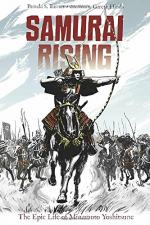|
This section contains 668 words (approx. 2 pages at 400 words per page) |

|
Samurai Rising Summary & Study Guide Description
Samurai Rising Summary & Study Guide includes comprehensive information and analysis to help you understand the book. This study guide contains the following sections:
This detailed literature summary also contains Topics for Discussion on Samurai Rising by Gareth Hinds and Pamela S. Turner.
Note: This study guide refers to the following version of this book: Turner, Pamela S. Samurai Rising: The Epic Life of Minamoto Yoshitsune. Charlesbridge, 2016.
Samurai Rising is a young adult nonfiction historical account by Pamela S. Turner of the life and times of legendary Japanese samurai warrior Minamoto Yoshitsune during and after the Samurai Civil War of 1180-1185. When the novel begins, Japan is in the final years of imperial rule. Two dominant clans, the Minamoto and the Taira, act as balances to one another while in support of the Retired Emperor, Go-Shirakawa, who rules through his young son, the Emperor. When a baby, Yoshitsune’s father, as well as Taira clan leader Taira Kiyomori, supported the Emperor in a political dispute. Unhappy with his reward and jealous of Kiyomori, Yoshitsune’s father decided to rebel against, and kidnap, the Retired Emperor. Kiyomori and the Taira samurai responded in defense of the Retired Emperor, killing Yoshitsune’s father and crushing the Minamoto.
With real power no longer in the hands of the Retired Emperor, but in the hands of Kiyomori, Kiyomori had unparalleled control. Keeping the Retired Emperor as a figurehead, Kiyomori exercised real power behind the scenes. Displaying compassion, Kiyomori refused to kill Yoshitsune and some of his half-brothers, including Yoritomo, even though he knew such an act could be dangerous since sons grow up to be men and enemies. Yoshitsune was sent away to a Buddhist monastery with the intent he become a monk, but as a child and teenager, he learned about his family’s history and vowed revenge on the Taira. Yoshitsune fled the monastery as a teenager and sought shelter with Lord Hidehira of the famous and wealthy city of Hiraizumi. There, Yoshitsune was welcomed and trained in the arts of the samurai. Meanwhile, Kiyomori’s power, influence, and wealth grew greater, causing him to become corrupt. When Kiyomori had his own grandson, Antoku, installed as Emperor, Yoritomo had had enough.
Yoritomo led a rebellion against the Taira, which opened up a civil war in 1180. Yoshitsune, upon learning this, traveled south to join his half-brother in rebellion. The Taira enjoyed early success in the war, but under the leadership of Yoshitsune, the reconstructed Minamoto clan and its growing number of friends and allies began to achieve important victories that toppled Taira control of the Japanese capital, Kyoto. Kiyomori died early in the war from illness. However, Yoshitsune, Yoritomo, and others did not merely want control of the Retired Emperor or the death of Kiyomori, but the total destruction of the Taira clan. The Minamoto, though outnumbered, fought a number of successful battles late in the war that sent the Taira reeling. Despite all of Yoshitsune’s successes, and despite all the respect he held among his troops, his fellow Minamoto leaders - including Yoritomo - were jealous and fearful of Yoshitsune’s successes.
In the final epic battle of the war, the Minamoto fleet took on the Taira fleet in the straits of Dan-no-Ura, which led to the demise of the Taira, the suicide of the child Emperor Antoku, and a smear campaign against Yoshitsune by other Minamoto leaders. With Yoritomo now in complete control of Japan, Yoshitsune was declared an outlaw. Chased down to Hiraizumi with a small band of loyal followers, Yoshitsune prepared for the end. While his loyal supporters fought to the death, Yoshitsune committed ritual suicide, while his wife and daughter were put to death at his wife’s request. Yoshitsune’s head was cut off, and returned to Yoritomo in Kyoto. A few years later, Yoritomo was killed when thrown from his spooked horse. Over the next several years, the leaders of the Minamoto engaged in a series of bloody murders and assassinations against each other, ultimately destroying their power and losing control of the government to the Hojo family, a minor branch of the Taira. Today, Yoshitsune is a legend in Japan, and was the samurai warrior to which all other samurai aspired to be.
Read more from the Study Guide
|
This section contains 668 words (approx. 2 pages at 400 words per page) |

|



